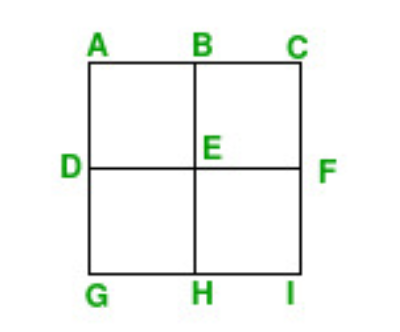最大化可以用坐标平面中的 N 个任意点形成的唯一正方形的数量
给定一个正整数N ,任务是找出在坐标平面上可以由N个任意点组成的唯一正方形的最大数量。
注意:任何两个不重叠的正方形都被认为是唯一的。
例子:
Input: N = 9
Output: 5
Explanation:
Consider the below square consisting of N points:

The squares ABEF, BCFE, DEHG, EFIH is one of the possible squares of size 1 which are non-overlapping with each other.
The square ACIG is also one of the possible squares of size 2.
Input: N = 6
Output: 2
方法:这个问题可以根据以下观察来解决:
- 观察如果N 是一个完美的正方形,那么当sqrt(N)*sqrt(N)个点形成一个sqrt(N)*sqrt(N)的网格并且它们都是相等的空间时,将形成最大数量的正方形。
- 但是当N 不是一个完美的正方形时,它仍然形成一个网格,但是数量最多的是一个小于N的完美正方形。
- 剩余的坐标可以放置在网格的边缘周围,这将导致最大可能的正方形。
请按照以下步骤解决问题:
- 初始化一个变量,比如ans ,它存储所形成的平方数。
- 找到最大可能的网格大小为sqrt(N)和所有可能的正方形的计数,直到长度为len的变量ans可以通过以下方式计算
 .
. - 将N的值减少len*len 。
- 如果N的值至少为 len ,则所有其他正方形都可以通过将它们放在另一个点簇中来形成。求步骤 2中计算的len值的平方数。
- 完成上述步骤后,打印ans的值作为结果。
下面是上述方法的实现:
C++
// C++ program for the above approach
#include
using namespace std;
// Function to find the maximum number
// of unique squares that can be formed
// from the given N points
int maximumUniqueSquares(int N)
{
// Stores the resultant count of
// squares formed
int ans = 0;
// Base Case
if (N < 4) {
return 0;
}
// Subtract the maximum possible
// grid size as sqrt(N)
int len = (sqrt(double(N)));
N -= len * len;
// Find the total squares till now
// for the maximum grid
for (int i = 1; i < len; i++) {
// A i*i grid contains (i-1)*(i-1)
// + (i-2)*(i-2) + ... + 1*1 squares
ans += i * i;
}
// When N >= len then more squares
// will be counted
if (N >= len) {
N -= len;
for (int i = 1; i < len; i++) {
ans += i;
}
}
for (int i = 1; i < N; i++) {
ans += i;
}
// Return total count of squares
return ans;
}
// Driver Code
int main()
{
int N = 9;
cout << maximumUniqueSquares(N);
return 0;
} Java
// Java program for the above approach
import java.io.*;
class GFG {
// Function to find the maximum number
// of unique squares that can be formed
// from the given N points
static int maximumUniqueSquares(int N)
{
// Stores the resultant count of
// squares formed
int ans = 0;
// Base Case
if (N < 4) {
return 0;
}
// Subtract the maximum possible
// grid size as sqrt(N)
int len = (int)(Math.sqrt(N));
N -= len * len;
// Find the total squares till now
// for the maximum grid
for (int i = 1; i < len; i++) {
// A i*i grid contains (i-1)*(i-1)
// + (i-2)*(i-2) + ... + 1*1 squares
ans += i * i;
}
// When N >= len then more squares
// will be counted
if (N >= len) {
N -= len;
for (int i = 1; i < len; i++) {
ans += i;
}
}
for (int i = 1; i < N; i++) {
ans += i;
}
// Return total count of squares
return ans;
}
// Driver Code
public static void main (String[] args)
{
int N = 9;
System.out.println( maximumUniqueSquares(N));
}
}
// This code is contributed by shivanisinghss2110.Python3
# Python program for the above approach
# for math function
import math
# Function to find the maximum number
# of unique squares that can be formed
# from the given N points
def maximumUniqueSquares(N):
# Stores the resultant count of
# squares formed
ans = 0
# Base Case
if N < 4:
return 0
# Subtract the maximum possible
# grid size as sqrt(N)
len = int(math.sqrt(N))
N -= len * len
# Find the total squares till now
# for the maximum grid
for i in range(1, len):
# A i*i grid contains (i-1)*(i-1)
# + (i-2)*(i-2) + ... + 1*1 squares
ans += i * i
# When N >= len then more squares
# will be counted
if (N >= len):
N -= len
for i in range(1, len):
ans += i
for i in range(1, N):
ans += i
# Return total count of squares
return ans
# Driver Code
if __name__ == "__main__":
N = 9
print(maximumUniqueSquares(N))
# This code is contributed by rakeshsahniC#
// C# program for the above approach
using System;
public class GFG
{
// Function to find the maximum number
// of unique squares that can be formed
// from the given N points
static int maximumUniqueSquares(int N)
{
// Stores the resultant count of
// squares formed
int ans = 0;
// Base Case
if (N < 4) {
return 0;
}
// Subtract the maximum possible
// grid size as sqrt(N)
int len = (int)(Math.Sqrt(N));
N -= len * len;
// Find the total squares till now
// for the maximum grid
for (int i = 1; i < len; i++) {
// A i*i grid contains (i-1)*(i-1)
// + (i-2)*(i-2) + ... + 1*1 squares
ans += i * i;
}
// When N >= len then more squares
// will be counted
if (N >= len) {
N -= len;
for (int i = 1; i < len; i++) {
ans += i;
}
}
for (int i = 1; i < N; i++) {
ans += i;
}
// Return total count of squares
return ans;
}
// Driver Code
public static void Main (string[] args)
{
int N = 9;
Console.WriteLine( maximumUniqueSquares(N));
}
}
// This code is contributed by AnkThonJavascript
输出:
5时间复杂度: O(sqrt(N))
辅助空间: O(1)